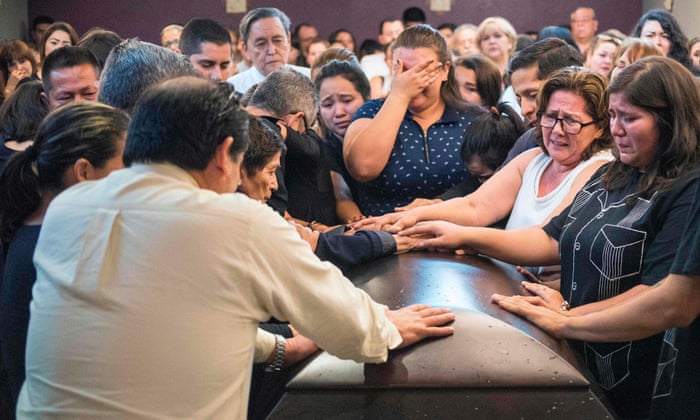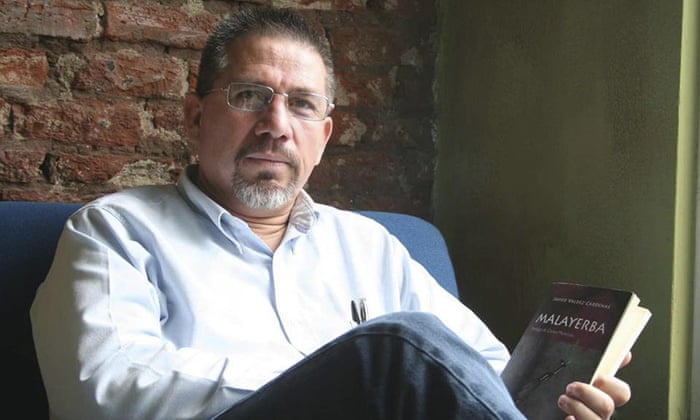'Why must I live in fear?' Mexico shaken after yet another journalist murdered
On Monday in Sinaloa, Javier Valdez was gunned down in broad daylight – the latest reporter to be caught up in Mexico’s wave of drug-related violence
Sinaloa said farewell to Javier Valdez, 50, on Tuesday, with hundreds of mourners spilling out the back door of the chapel in a Culiacán funeral home. Photograph: Hector Parra/AFP/Getty Images




Javier Valdez was shot 12 times in what colleagues said was a targeted attack. Photograph: Uncredited/AP
Javier Valdez wrote his own epitaph. After the 23 March murder of Miroslava Breach, a reporter in the northern Mexican city of Chihuahua, Valdez tweeted: “Let them kill us all, if that is the death sentence for reporting this hell. No to silence.”
Valdez never stayed silent, reporting fearlessly on dynastic rivalries within the Sinaloa cartel – as well as the often forgotten victims of mafia violence.
He was killed on Monday at midday, barely a block from the office of Ríodoce (Twelfth River), the newspaper he co-founded in 2003. He was shot 12 times – perhaps symbolically – in what colleagues say was a targeted attack.
“We always knew this could occur. We were conscious of it, and never denied that we were scared,” said Ismael Bohórquez, director of Ríodoce.
Unlike many newspapers in Mexico – which have simply given up attempting to explain the drug-fueled violence that has claimed 200,000 lives in the past decade – neither Valdez nor Ríodoce had shied away from covering topics like crime and corruption. His sources were solid, and he may have calculated that living in a region dominated by one all-powerful cartel would protect him from getting caught in the crossfire.
But such certainties have disappeared amid a succession crisis in the Sinaloa cartel after the arrest and extradition of Joaquín “El Chapo” Guzmán.
“We crossed a line. I don’t know what happened,” said Bojórquez in an interview at the modest Ríodoce offices in Culiacán. “These aren’t lines in the street; you don’t know when you’ve crossed them.”
Sinaloa said farewell to Valdez, 50, on Tuesday, with hundreds of mourners spilling out the back door of the chapel in a Culiacán funeral home already overflowing with floral bouquets. Colleagues remembered him as a cheerful figure, never seen without the Panama hat that was laid on the dark wood of his coffin.
“Javier was easygoing, someone you liked a lot, very empathetic … and someone that tried to find a little hope in everything,” said Andrés Villarreal, an investigative reporter at Ríodoce, who fought back tears as he spoke.
The murder sparked outrage in Mexico, where six reporters have been murdered so far this year, reinforcing the country’s reputation as the most dangerous place to practice journalism in the region.
Some independent outlets stopped publishing as part of a protest dubbed “a day without journalism”.
The press freedom advocacy organization Article 19 counts 104 journalist murders in Mexico since 2000. Reporters Without Borders ranks Mexico No 147 on its annual press freedom rankings, one spot ahead of Russia.
“Never have we seen those in the industry so outraged and united,” tweeted Daniel Moreno Chávez, director of the news outlet Animal Politico.
This year’s spate of killings have horrified the country. Breach was gunned down as she drove her son to school in the northern city of Chihuahua. The newspaper publishing her work, Norte, subsequently closed, saying it couldn’t keep its journalists safe.
Cecilio Pineda, founder of a news site in the rugged Tierra Caliente region of the poppy-producing Guerrero state, was shot 10 times while lying in a hammock.
Last weekend, seven reporters travelling through Guerrero to investigate a confrontation between rival gangs were swarmed by 100 gunmen, beaten and robbed of their belongings.
But as is common in Mexico, the attacks have all languished in impunity. A special prosecutor’s office was established in 2006 to take over cases of crimes committed against journalists from potentially corrupt or inept investigators; it has resulted in just three convictions.
“It’s useless,” said Javier Garza Ramos, the former editor of the newspaper El Siglo de Torreón, whose building was shot at five times between 2009 and 2013; four employees have been kidnapped. “The [federal] and state attorneys general don’t investigate, much less punish.”
President Enrique Peña Nieto has expressed regret over Valdez’s murder, and on Wednesday he announced new protection measures for the media. However the president was widely criticised for failing to include any journalists in the plan’s preparation or launch.
The country’s interior minister, Miguel Ángel Osorio Chong, also promised to act and raise it with Mexico’s 31 state governors.
But freedom of speech advocates said the plan was too little, too late, especially as some of those same governors have become notorious for failing to prevent attacks on the the media – and even paying or pressuring local reporters to provide positive coverage.
In Culiacán, the capital of Sinaloa, local journalists marched into state government offices on Tuesday and refused to leave without speaking to the governor, Quirino Ordaz Coppel.
“Impunity is what killed Javier – and it’s what will kill all of us,” thundered one reporter in a series of testy exchanges.
“Why can’t I go home in peace? Why do I have to live in fear?” sobbed another.
Ordaz, who at times seemed on the verge of losing his temper, promised a special prosecutor to investigate. “Javier was a friend. I have the same outrage as you.”
Valdez chronicled crime and its consequences in Sinaloa, writing three books and penning a weekly column in Ríodoce called Weeds. His work showed a rare empathy, especially for victims of violence, in a state where the illegal drugs business has sunk deep roots and the government is often seen by local people as little more than another faction in the crime war.
“When news would break, we would trade tips on what happened, but he would go look for the victims,” said Ismael Medina, a Culiacán reporter who knew Valdez at university. “He would go talk to them and even help them.”
Colleagues said that Valdez knew the value of discretion, but refused to pull his punches when reporting on the cartels, even when the country’s drug wars heated up in the mid-2000s.
In an interview last year with Rompeviento TV, Valdez said: “You have to assume the task that falls to you as a journalist. Either that, or you play dumb.
“I don’t want to be asked: ‘What were you doing in the face of so much death ... why didn’t you say what was going on?’”
Conditions started to change after Guzmán’s third arrest last year – a move which left the Sinaloa cartel splintered between factions loyal to El Chapo’s sons and those loyal to his former right-hand man, Dámaso López.
When Ríodoce ran a recent cover story on López, the magazine’s delivery trucks were followed by gangs of men who bought up every copy – a tactic often used by criminals or politicians who want to suppress a story. López was arrested earlier this month,
“The new generation is much more violent. They don’t think,” said one Ríodoce staffer. “That they would attack a newspaper like this tells us a lot. And changes a lot of our ways doing things.”
Valdez’s colleagues presume that his death was related to the internecine war with the Sinaloa cartel, but nobody at the magazine could say who might have been responsible. “We don’t know which side it was,” Bohórquez said.
What they were determined to make clear, however, was that they would continue publishing and covering organized crime, even after losing their best-known reporter.
“You can’t do journalism in Sinaloa without covering the topic of drug trafficking,” Bohórquez said. “We knew it was important to publicly expose it – and we will continue do that, because that is our commitment to the people here.”

